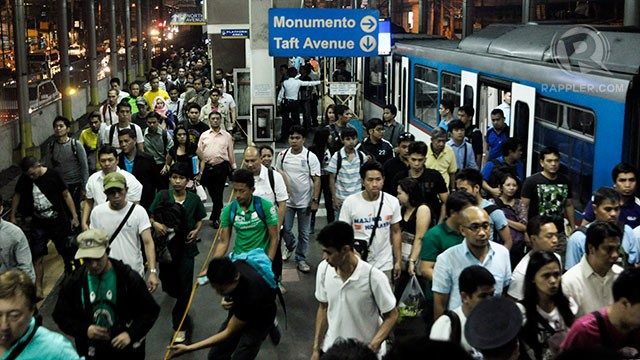SUMMARY
This is AI generated summarization, which may have errors. For context, always refer to the full article.


MANILA, Philippines (UPDATED) – The government conducted on Wednesday, May 7, a dry run of two proposed transportation schemes that would relieve commuters of heavy congestion in the Metro Rail Transit (MRT) 3.
The Land Transportation Franchising and Regulatory Board (LTFRB) and Land Transportation Office (LTO) deployed a high-capacity articulated bus on EDSA on the same day that the MRT 3 express train service finally embarked on its test run.
Watch this report below.
The articulated bus, manufactured by MAN, will travel from MRT North EDSA station in Quezon City to MRT Taft station in Pasay City. It will be exclusive to southbound passengers of MRT 3, and would have stops at only 3 MRT stations: Buendia, Ayala, and Taft.
The bus would pass through the EDSA underpass and overpass, make stops at the 3 MRT stations, take a turn at SM Mall of Asia, and end near the Ninoy Aquino International Airport Terminal 2 (NAIA2).
“Through the articulated bus, we would give a temporary solution to the congestion in MRT stations while waiting for the new trains,” LTFRB chairman Winston Ginez said.
The MRT 3 Express Train service would be deployed to the most congested MRT stations during peak hours. All Express Trains would make only 5 stops from their deployment from the end-stations.
Southbound Express Trains would be deployed from May 7 to 13, from 7am to 9am.
The first morning Express Train would make its first or “pick up” stop at the Quezon Avenue station, the second Express Train at the GMA-Kamuning station, and the third Express Train at the Cubao station. Each one will then proceed to the Buendia, Ayala, Magallanes, and Taft Avenue stations.
The same experimental morning schedule will continue from May 14 to 20, with the addition this time of the Northbound Express Trains from 5pm to 7pm.
The first afternoon Express Train would make a “pick up” stop at the Magallanes station, the second Express Train at the Ayala station, and the third Express Train at the Buendia station. Each would then proceed to the Cubao, GMA-Kamuning, Quezon Avenue, and North Avenue stations.
The “pick-up” stop is intended to board passengers from one of the more congested stations, before going directly to the other 4 stations, where most riders will disembark. This means that the morning and afternoon trips will each ply 3 different routes to maximize the experiment’s impact on riders.
Transportation Secretary Joseph Emilio Abaya is hopeful that the scheme would work.
“We hope that this trial run will yield positive results for passengers. Ideally, it will increase mobility – meaning it will get commuters from their origins to their destinations more quickly – as well as lessen waiting time at our most congested stations during peak hours,” said Abaya.
Initial feedback positive
Jaded MRT 3 riders were understandably skeptical about the MRT express train service and predicted its failure, but an hour into the test run, the feedback from passengers were generally positive based on their posts on social media.
On Twitter, some MRT riders who tried out the express trains gave initial rave reviews.
Twitter user Ian Vincent said, “That was quick. Took me only 10 mins to stay on the line and get on the train.”
Jen Lim tweeted, “Thanks to mrt express train. Bilis (It’s fast) :>” while Bakluzhi said, “QC to Makati in just half an hour!!! Panalo ang MRT Express Train 🙂 (The MRT Express Train is a winner)”
Still, there were those who felt the express train system made it even worse for passengers, and posted photos of people in long lines, which the scheme was supposed to address. Some suggested “color coding” the trains to set apart express trains from regular ones.
The deployment of express trains was originally scheduled on April 30, but was postponed pending suggestions and recommendations from the riding public.
On average, MRT 3 services 580,000 passengers daily – much more than its “crush capacity” of 500,000 and designed capacity of only 360,000 daily.
The Department of Transportation and Communications (DOTC) had said that the only way to solve MRT 3 problems is the acquisition of new trains.
The DOTC has awarded the P3.8-billion train supply contract to Dalian Locomotive and Rolling Stock Group of China. The first batch of the 48 new trains are expected to arrive early 2015. – Rappler.com
Add a comment
How does this make you feel?
There are no comments yet. Add your comment to start the conversation.